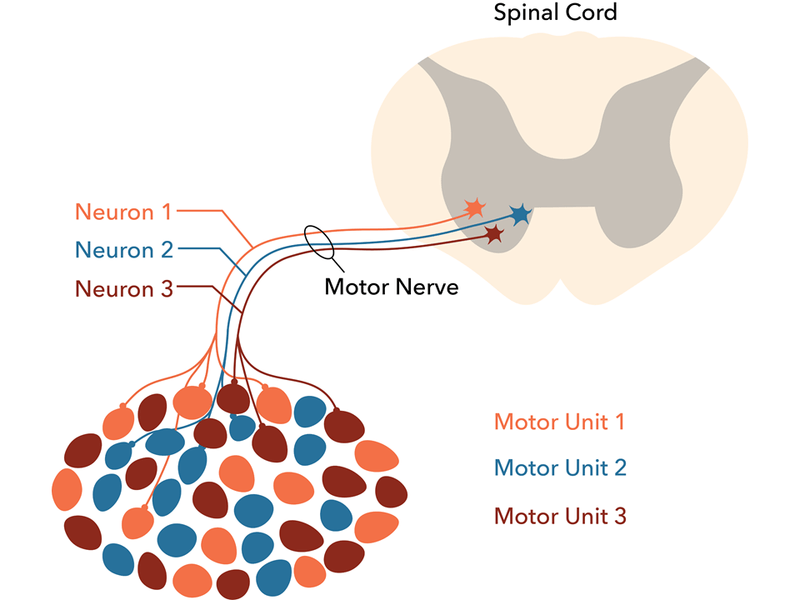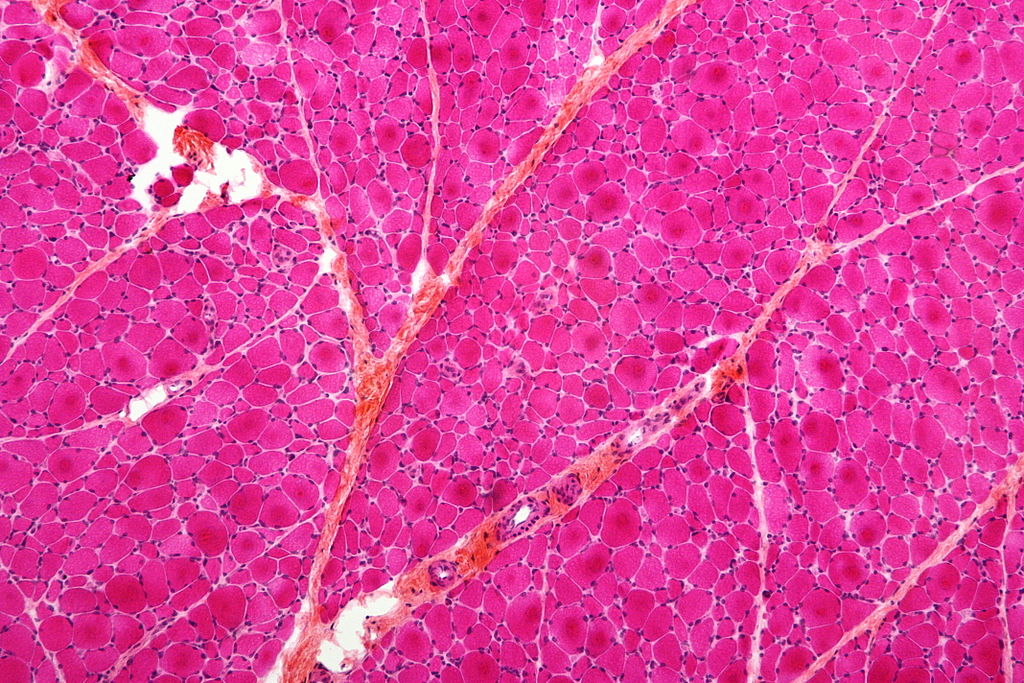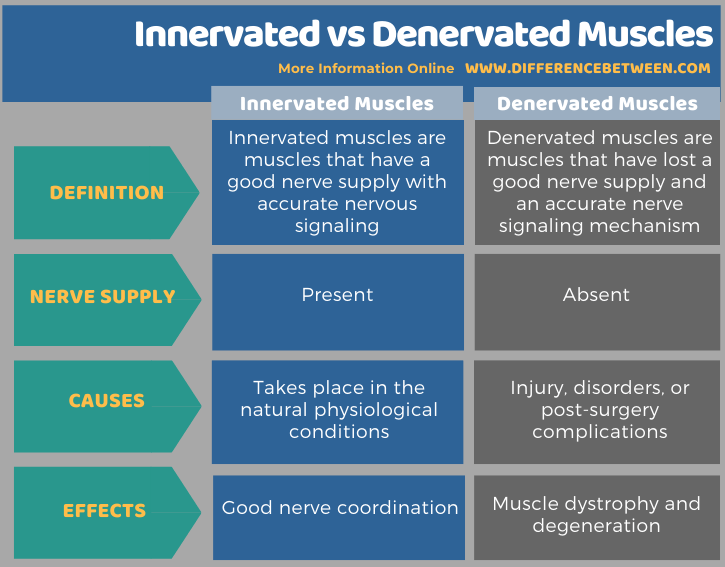Difference Between Innervated and Denervated Muscles
Table of Contents
The key difference between innervated and denervated muscles is based on the nervous supply received by the muscles. While innervated muscles have a good nervous supply mediated through nervous coordination, denervated muscles do not have a nerve supply, so their muscular functionality is lost.
Muscular movements have a neurogenic property. Therefore, muscular movements are mediated by the nerve signals that pass through them in order to ensure their appropriate functionality. In any failure where the nervous supply is blocked or inhibited, muscle dystrophy and degeneration of muscles take place.
CONTENTS
1. Overview and Key Difference
2. What are Innervated Muscles
3. What are Denervated Muscles
4. Similarities Between Innervated and Denervated Muscles
5. Side by Side Comparison – Innervated vs Denervated Muscles in Tabular Form
6. Summary
What are Innervated Muscles?
Innervated muscles are muscles that have a good supply of nerves. Therefore, their nervous coordination is well manipulated. A muscle is innervated through the use of a single motor axon. In some cases, more than one muscle can be innervated by a single axon. However, when this phenomenon takes place, all the fibres innervated through one axon is termed as a motor unit. Eventually, these motor units form thick fibres that can perform muscular movements. Muscle innervation is mediated by the presence of neurotransmitters that carry these neurogenic signals to muscles. They secrete at the neuromuscular junctions to pass the signal through a generated action potential.

Figure 01: Innervated Muscles – Motor Unit
The process of muscle innervation is essential to maintain the integrity of the muscles and for the accurate functioning of muscles. Failure of this process results in muscle denervation, leading to muscular dystrophy and muscle degeneration.
What are Denervated Muscles?
Denervated muscles are muscles that have lost the nervous supply through a process called denervation. Denervation may take place through injury, inborn disorders, or due to post-surgery complications. Following denervation, muscles lose the nervous communication that provides the signals for coordination of movements. Therefore, this process leads to muscle dystrophy, causing physiological disorders.
In some cases, denervated muscles can be present due to inborn genetic errors such as Amyotrophic lateral sclerosis (ALS) or following certain disorders such as Post-polio syndrome. The severity of denervated muscles depends on the location of denervation. In certain cases, denervated muscles can lead to the complete dysfunction of a particular organ or tissue.

Figure 02: Denervated Muscles
Denervated muscles usually undergo muscular atrophy and muscle degeneration. This, in turn, leads to the reduction of muscle mass, muscle size and muscle quantity. It also affects muscular movements of contraction and relaxation. Denervated muscles can be detected through Magnetic resonance imaging scans or through ultrasonography.
What are the Similarities Between Innervated and Denervated Muscles?
- Innervated and denervated muscles are two types of muscles.
- Both are based on the nervous supply to muscles.
- They focus on aspects of muscle coordination.
What is the Difference Between Innervated and Denervated Muscles?
Muscles play an important role in regulating movement and structure in higher-level organisms. Both innervated and denervated muscles deal with the concept of nerve supply to muscles. However, while innervated muscles refer to muscles that receive a good nerve supply, denervated muscles refer to the muscles that have lost the nerve supply. So, this is the key difference between innervated and denervated muscles. Due to this difference, the quality of each muscle type varies.
The below infographic lists the differences between innervated and denervated muscles in tabular form.

Summary – Innervated vs Denervated Muscles
Innervated muscles refer to the muscles that have a good supply of nerves, while denervated muscles refer to muscles that do not have a good supply of nerves. Innervation takes place under physiological conditions, while denervation takes place following an injury, a post-surgery complication or due to an inborn metabolic or genetic error. However, following denervation, there is a possibility of reinnervation depending on the severity level. Thus, this is the summary of the difference between innervated and denervated muscles.
Reference:
1. Hinsey, Joseph C., and Search for more papers by this author. “THE INNERVATION OF SKELETAL MUSCLE.” Physiological Reviews, 1 Oct. 1934, journals.physiology.org/doi/abs/10.1152/physrev.1934.14.4.514.
2. O;, Pieber K;Herceg M;Paternostro-Sluga T;Schuhfried. “Optimizing Stimulation Parameters in Functional Electrical Stimulation of Denervated Muscles: a Cross-Sectional Study.” Journal of Neuroengineering and Rehabilitation, U.S. National Library of Medicine, Available here.
Image Courtesy:
1. “Motor unit” By Daniel Walsh and Alan Sved – Own work (CC BY-SA 4.0) via Commons Wikimedia
2. “Denervation atrophy – intermed mag” By Nephron – Own work (CC BY-SA 3.0) via Commons Wikimedia
ncG1vNJzZmivp6x7pbXFn5yrnZ6YsqOx07CcnqZemLyue8OinZ%2Bdopq7pLGMm5ytr5Wau261zaecq66RqbKlecCnm2aclaOys8LArZydZZ2qwKS4xKxm